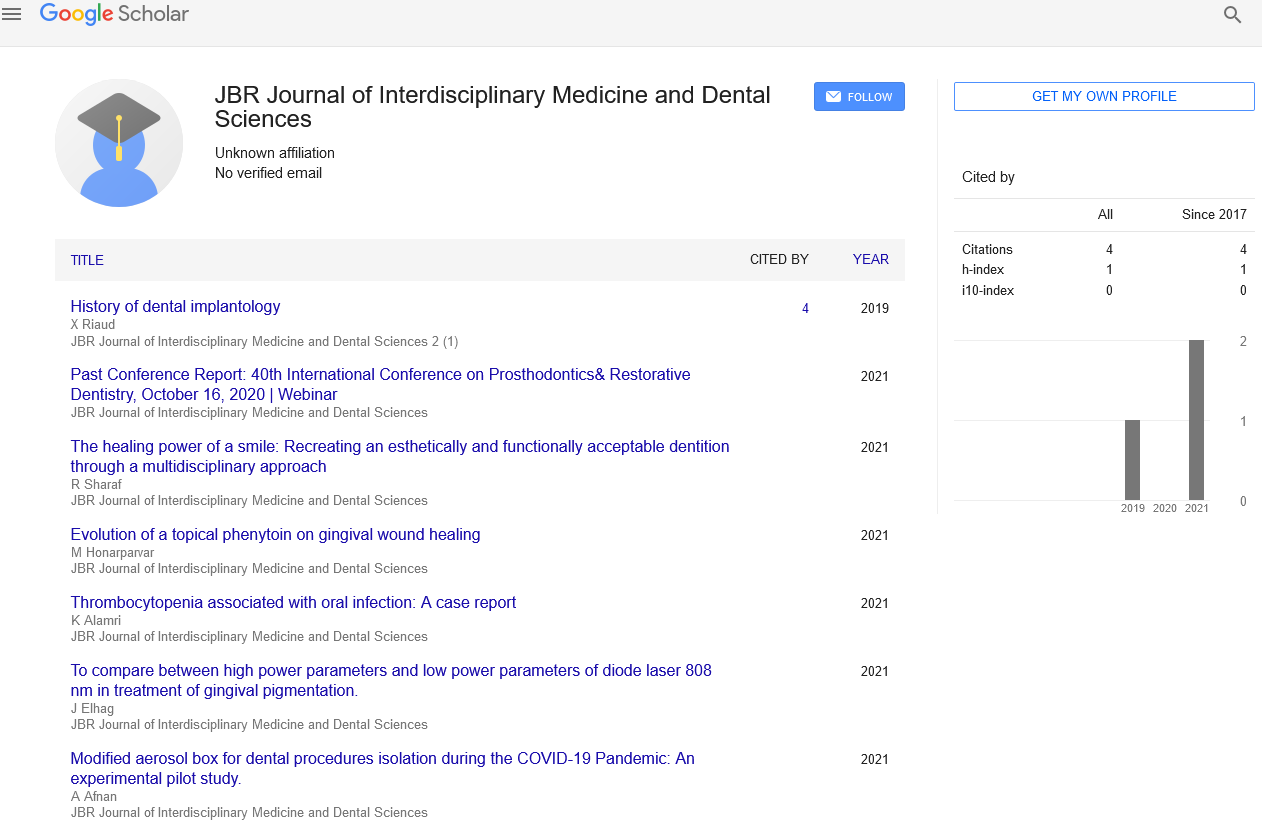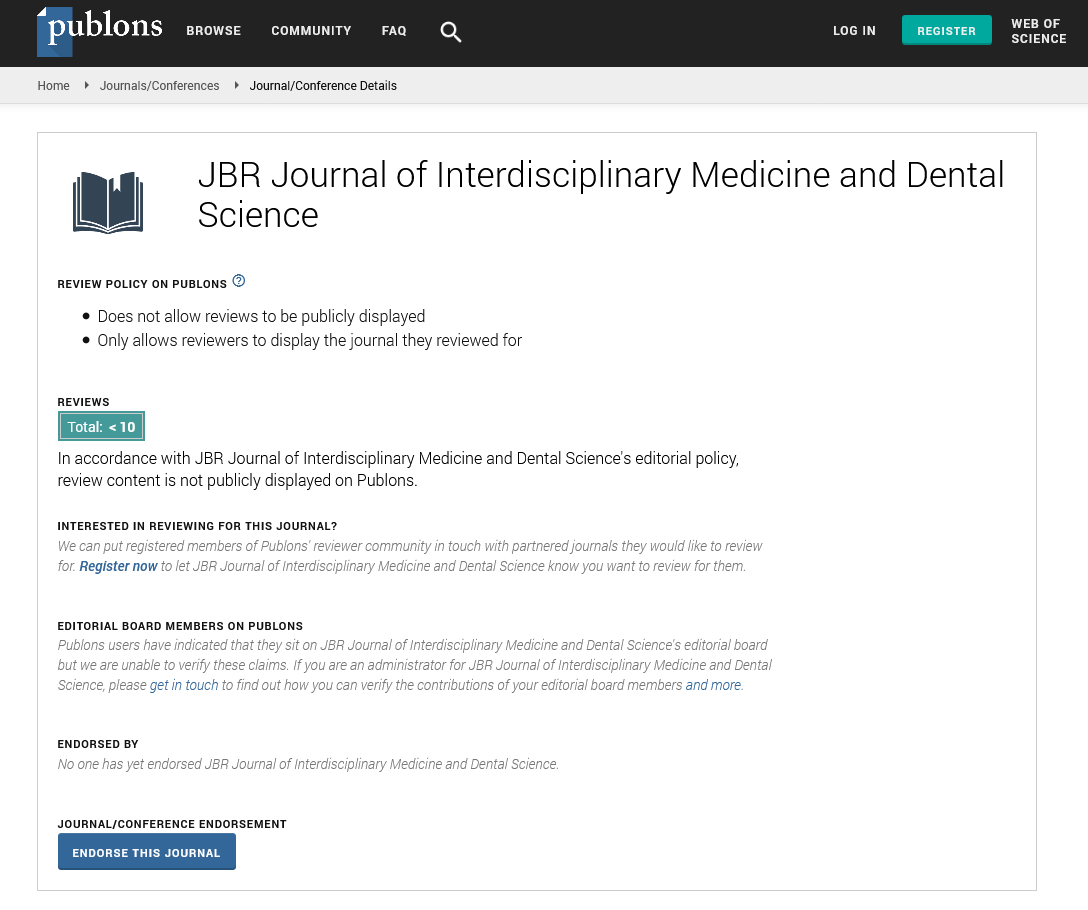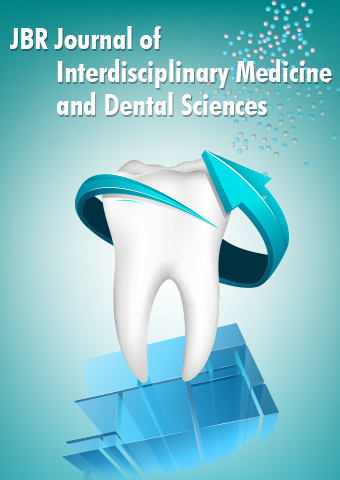Editorial - JBR Journal of Interdisciplinary Medicine and Dental Sciences (2023) Volume 6, Issue 4
Advancements in Maxillofacial Prosthetics: Enhancing Quality of Life for Patients
James Watt*
Department of Dental Sciences, Brazil
Department of Dental Sciences, Brazil
E-mail: watt_james69@gmail.com
Received: 1-July-2023, Manuscript No. jimds-23-108424; Editor assigned: 4-July-2023, PreQC No. jimds-23-108424 (PQ); Reviewed: 19-July-2023, QC No. jimds-23-108424; Revised: 24-July-2023, Manuscript No. jimds-23-108424 (R); Published: 31-July-2023, DOI: 10.37532/2376- 032X.2023.6(4).95-97
Abstract
Maxillofacial prosthetics is a specialized field of dentistry and healthcare dedicated to restoring the function and aesthetics of patients with facial defects or impairments. This article explores the advancements in maxillofacial prosthetics, highlighting innovative techniques and materials that have significantly improved patient outcomes. Custommade facial prostheses, ocular prostheses, and ear prostheses are created using lightweight, biocompatible, and durable materials like silicone rubber. The emergence of 3D printing technology has revolutionized the fabrication process, allowing for highly accurate and customized prosthetic devices. Osseointegrated implants have transformed prosthetic retention by offering a secure anchor, enhancing stability, and reducing discomfort. Additionally, facial reconstruction and transplantation have provided hope for patients with severe facial disfigurement. Beyond physical restoration, maxillofacial prosthetics addresses psychosocial aspects, providing comprehensive care to rebuild confidence and improve the quality of life for patients. With ongoing research and collaboration, the future of maxillofacial prosthetics holds great promise in further enhancing patient well-being.
Keywords
Maxillofacial prosthetics • Facial defects • Facial impairments • Facial prostheses • Ocular prostheses
Introduction
Maxillofacial prosthetics is a highly specialized branch of dentistry and healthcare that focuses on restoring both function and aesthetics to individuals with facial defects or impairments [1]. These conditions can arise from various causes, such as congenital anomalies, traumatic injuries, surgical interventions, or medical conditions like cancer. The field of maxillofacial prosthetics encompasses a diverse range of prosthetic devices, including facial prostheses, ocular prostheses (artificial eyes), and ear prostheses [2]. Each device is meticulously custom-made to suit the unique needs of the patient, with the overarching goal of not only addressing physical deformities but also enhancing vital functions, such as speech, swallowing, and facial expression. Over the years, significant advancements in materials, technology, and surgical techniques have propelled the field of maxillofacial prosthetics to new heights [3]. These advancements have played a pivotal role in improving patient outcomes and fostering a renewed sense of hope for those who face the challenges of living with facial disfigurements. Moreover, the developments in this field extend beyond the physical aspects, with a growing emphasis on addressing the psychosocial impacts of facial defects and the provision of comprehensive support for patients [4]. In this article, we will explore the recent breakthroughs and innovative solutions that have reshaped the landscape of maxillofacial prosthetics. From cutting-edge materials to advanced 3D printing technology and the emergence of osseointegrated implants, we will delve into the mechanisms that underpin the remarkable progress in this field [5]. Additionally, we will highlight the transformative potential of facial reconstruction and transplantation in providing individuals with severe facial disfigurements an opportunity to reclaim a more natural appearance and functional abilities. Beyond the technical aspects, we will also examine the broader implications of maxillofacial prosthetics on patients’ lives, delving into the psychosocial challenges they may encounter [6]. Moreover, we will discuss the vital role of multidisciplinary support in helping patients adapt to their new physical appearance and rebuild their self-esteem and confidence. With ongoing research and collaboration between various disciplines, the future of maxillofacial prosthetics holds immense promise, offering not only physical restoration but also holistic care to improve the quality of life for patients worldwide [7].
Material and Methods
Maxillofacial prosthetics is a specialized field of dentistry and healthcare that focuses on restoring and enhancing the function, aesthetics, and quality of life for patients with facial defects or impairments. These defects can be caused by congenital conditions, trauma, surgical interventions, or medical conditions like cancer [8]. Maxillofacial prosthetic solutions encompass a range of innovative techniques and materials that continue to evolve, providing hope and improved outcomes for patients worldwide.
Facial prosthetics: a comprehensive approach
Maxillofacial prosthetics encompasses various types of prosthetic devices, including facial prostheses, ocular prostheses (artificial eyes), and ear prostheses. These prosthetic devices are custom-made for each individual patient to address specific facial and cranial defects [9]. The goal is to restore not only the physical appearance but also the essential functions such as speech, swallowing, and facial expression.
State-of-the-art materials
The development of advanced materials has significantly contributed to the progress of maxillofacial prosthetics. Modern materials used in these prostheses are lightweight, biocompatible, and durable, leading to improved comfort and longevity for patients. Silicone rubber is one of the most widely used materials in facial prosthetics due to its natural appearance, flexibility, and ease of shaping to match individual facial contours [10]. Additionally, advancements in 3D printing technology have revolutionized the fabrication process of facial prostheses. Digital scans of a patient’s face can now be used to create highly accurate and customized prosthetic devices, reducing production time and enhancing the overall fit and function.
Osseo integrated implants for prosthetic retention
Securing facial prostheses used to be a challenge, as traditional methods relied on adhesives or harnesses, which were often uncomfortable and aesthetically limited. The advent of osseointegrated implants has changed this landscape dramatically. Osseointegration involves surgically implanting titanium screws or posts into the facial bones, such as the skull or jaw. These implants integrate with the bone over time, providing a secure anchor for attaching facial prostheses. This technique not only enhances the stability and retention of prosthetic devices but also reduces skin irritation and improves patients’ confidence and daily function.
Facial reconstruction and transplantation
In cases of severe facial disfigurement due to accidents or advanced cancer, facial reconstruction and transplantation have emerged as transformative solutions. Surgical teams now have access to innovative techniques that involve transplanting facial tissues, including muscles, skin, and bones, from deceased donors to restore a more natural appearance and function. While these procedures are complex and require multidisciplinary collaboration, they offer new hope for patients who have experienced significant facial trauma or disfigurement. Advanced immunosuppressive medications have also played a crucial role in ensuring the success of facial transplantation by preventing rejection of the transplanted tissues.
Psychosocial aspects and patient support
Maxillofacial prosthetics go beyond physical restoration; they also address the psychosocial aspects of living with facial defects. Patients who undergo facial reconstruction or receive prosthetic devices may experience emotional challenges related to body image, self-esteem, and social interactions. To provide comprehensive care, maxillofacial prosthetic specialists work closely with psychologists, social workers, and support groups to help patients adapt to their new appearance, rebuild confidence, and lead fulfilling lives.
Discussion
Maxillofacial prosthetics has come a long way, and the field continues to witness remarkable advancements that offer hope and restoration to patients with facial defects or impairments. From innovative materials and 3D printing technology to osseointegrated implants and facial transplantation, the future of maxillofacial prosthetics holds immense promise for enhancing the quality of life for patients worldwide. As research, technology, and collaboration progress, the field will undoubtedly continue to make significant strides in restoring both function and aesthetics for those in need. With a commitment to innovation, compassion, and comprehensive care, the field is poised to offer brighter futures for countless individuals around the world. Maxillofacial prosthetics stands as a testament to the transformative power of modern medicine and the unwavering dedication of healthcare professionals in enhancing the lives of their patients.
Conclusion
The field of maxillofacial prosthetics has witnessed remarkable advancements, transforming the lives of individuals with facial defects and impairments. From the development of advanced materials like silicone rubber to the integration of 3D printing technology, custom-made prosthetic devices now offer improved comfort, natural aesthetics, and enhanced functionality. The introduction of osseointegrated implants has revolutionized prosthetic retention, providing patients with newfound stability and confidence. Facial reconstruction and transplantation have emerged as transformative solutions for those with severe facial disfigurement, offering hope and a chance at reclaiming a more natural appearance and essential functions. These complex procedures, supported by advancements in immunosuppressive medications, have opened up new possibilities for patients with once-unthinkable challenges. Moreover, the focus on psychosocial aspects has been central to the holistic approach of maxillofacial prosthetics. The collaboration of specialists from multiple disciplines, including psychologists and social workers, has helped patients navigate the emotional journey of adjusting to their new appearance and rebuilding self-esteem. As we peer into the future of maxillofacial prosthetics, the prospects appear bright with ongoing research and collaboration. The continuous evolution of materials, technology, and surgical techniques promises to further improve patient outcomes and overall quality of life. By addressing not just physical restoration but also the emotional well-being of patients, maxillofacial prosthetics exemplifies the potential of healthcare to touch lives profoundly. In conclusion, the advancements in maxillofacial prosthetics have transcended beyond mere medical interventions, fostering hope, dignity, and confidence in patients faced with facial defects or impairments. With a commitment to innovation, compassion, and comprehensive care, the field is poised to offer brighter futures for countless individuals around the world. Maxillofacial prosthetics stands as a testament to the transformative power of modern medicine and the unwavering dedication of healthcare professionals in enhancing the lives of their patients.
References
- Pandve HT. Recent advances in oral health care in India? Indian J Dent Res. 20,129–130 (2009).
- Dudala SN, Arlappa N. An updated Prasad's socio economic status classification for 2013. Int J Res Dev Health. 1, 26–28 (2013).
- Sharda A, Sharda S. Factors influencing choice of oral hygiene products used among the population of Udaipur, India. Int J Dent Clinics. 2, 7–12 (2010).
- Bhat PK, Kumar A, Aruna CN. Preventive oral health knowledge, practice and behaviour of patients attending dental institution in Bangalore, India. J Int Oral Health 2, 17–26 (2010).
- Dasgupta U, Mallik S, Naskar S et al. Dental problems and its epidemiological factors- a study on adolescent and adult patients attending dental OPD of a tertiary care hospital in Kolkata, India. J Dent Med Sci. 5, 1–7 (2013).
- Barrieshi-Nusair K, Alomari Q, Said K. Dental health attitudes and behaviour among dental students in Jordan. Community Dent Health. 23,147–151 (2006).
- Vadiakas G, Oulis CJ, Tsinidou K et al. Socio-behavioural factors influencing oral health of 12 and 15 year old Greek adolescents. A national pathfinder survey. Eur Arch Paediatr Dent. 12, 139-145 (2011).
- Kwan SY, Petersen PE, Pine CM et al. Health-promoting schools: an opportunity for oral health promotion. Bull World Health Organ. 83, 677-685 (2005).
- Sharma N, He T, Barker ML et al. Plaque Control Evaluation of a Stabilized Stannous Fluoride Dentifrice Compared to a Triclosan Dentifrice in a Six-Week Trial. J Clin Dent. 24, 31-36 (2013).
- Dwivedi S, Mittal M, Vashisth P et al. Oral Hygiene Pattern observed in Primary School Children as Reported by Their Mother: A Longitudinal Study. World J Dent. 3, 308-312 (2012).
Indexed at, Google Scholar, Crossref


